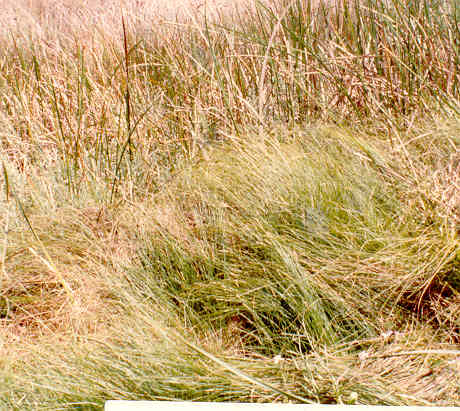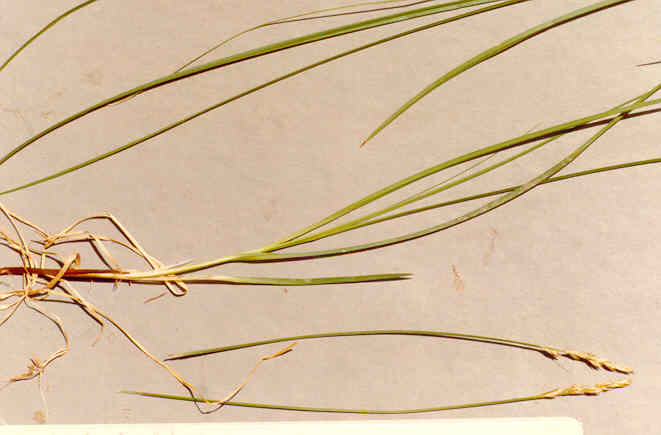
Carex praegracilis W. Boott
 |
Carex praegracilis W. Boott
Cyperaceae (Sedge Family)Native & S. AmericaClustered Field Sedge |
March Photo
Plant Characteristics:
Grasslike plant, perennial, sometimes dioecious; rhizome 2-5 mm. thick;
culms 2-7.5 dm. tall, sharply triangular, usually overtopping the leaves,
sometimes quite strongly; leaf blades 1-3 mm. wide, erect-ascending, flat or
somewhat channeled, light green; basal leaf sheaths dark brown or blackish;
spikes closely aggregated, but the lower ones readily distinguishable and
somewhat separate in a linear-oblong or oblong-ovoid head, 1-5 cm. long, 6-10
mm. thick; scales with conspicuous hyaline margins and lighter mid-vein, the
lower scales cuspidate, the upper ones acuminate, concealing the perigynia,
bracts absent or the lower 1 or 2 present, usually shorter than the head;
perigynia, plano-convex, ovate or ovate-lanceolate straw-colored or at maturity
brownish-black, coriaceous, dull nerveless ventrally, lightly severally-nerved
dorsally, spongy and rounded at the base, sharp edged, serrulate above the
middle, tapering at apex into a beak 1/3-1/2 as long as body, the beak
serrulate.
Habitat:
Wet meadows and streams throughout Calif. at middle to low elevs.;
Channel Ids.; Western N. America.
Name:
Carex is the classical Latin
name. (Munz, Flora
So. Calif. 884). Latin, prae,
before and gracilis, slender.
(Jaeger 112,206). The
species name may refer to the slender culms.
General:
Uncommon in the study area. Found
in one large colony at 23rd Street. In 1994 the County of Orange constructed a new walking path
more or less parallel to Irvine Ave. The
toe of the bank supporting the path in the 23rd St. area destroyed the Carex
praegracilis colony. Every time
I walk through this area I look for Carex plants
but as of this edit, 2002, I have found none.
(my comments). Carex spp. were used by
the Indians for wrapping elements of basket wefts.
(Heizer & Elsasser 243).
The roots of C. mendocinoensis
were used for basket making. These
roots, 5-6 ft. in length were soaked overnight in water, the weaver then peeled
off the bark or outer skin and rolled it into small coils.
The remaining root was split for foundation material.
No mention is made of what the coils were used for.
(Murphy 6). The
root of C. ex-siccata was used to produce a black dye.
The root was burned in warm ashes with water added.
(Murphy 8). C.
nebraskensis was the favorite food of the buffalo.
(Murphy 51). Buffalo
grass? (my question). The largest genus of flowering plants in
Calif. (Munz, Calif.
Flora 1429).
Jepson describes 126 different species of Carex
living in Calif. (Robbins et al.
114). A
genus of over 1000 species. (Munz, Flora
So. Calif. 884).
Carex species have been know to
cause hay fever and asthma. (Fuller
381). Many
species are invasive, especially those with rhizomes.
This is one of the most effective genera for knitting moist or wet soil. (Hickman,
Ed. 1107). Reconfirmed
identity by keying a specimen in May 1994.
(my comment).
Text Ref:
Hickman, Ed. 1132; Mason 223; Munz, Calif.
Flora 1438; Munz, Flora So. Calif.
893; Roberts 42.
Photo Ref:
May 3 84 # 6,7; March-April 87 # 14.
Identity: by R. De Ruff,
confirmed by F. Roberts.
First Found: May 1984.
Computer Ref: Plant Data 18.
Have Plant Specimen.
Last edit 5/6/05.
 |
 |